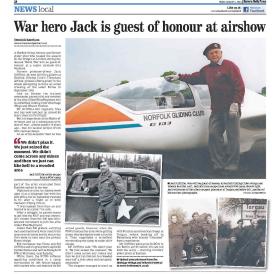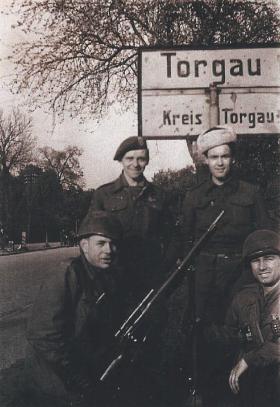John 'Jack' Douglas Griffiths was born on the 15 November 1921, and came from Bedford. He enlisted into the Royal Corps of Signals on the 29th April 1939. Before enlisting his civilian trade was a Post Office worker. [1] & [2]
In 1943 he volunteered for Airborne Forces and joined The Glider Pilot Regiment. Upon completion of all his flying training he was posted to ‘A’ Squadron, which was stationed at RAF. Harwell.
He took part in Operation ‘Mallard’, which was the reinforcement ‘Lift’ on the evening of ‘D’ Day, 6 June 1944. He was the 2nd Pilot to S/Sgt. William Meiklejohn, and they were flying a Horsa glider, C/N: 143, carrying men of the 2nd Bn, The Oxfordshire & Buckinghamshire Light Infantry, to LZ. ‘W’ in Normandy. They landed successfully and the next day returned to England.
The next operation he took part in was Operation ‘Market-Garden’, and this time the Horsa glider, C/N: 925, was carrying a Jeep, two trailers of ammunition and four men of ‘C’ Transport Platoon, 250th (Airborne) Light Composite Company, RASC. What follows is his first hand account.
Three of us managed to escape over the wire, met up with American troops at Torg
“I flew as 2nd Pilot to S/Sgt. Mieklejohn, and landed on LZ ‘X’ on the 18th September. Our flight was uneventful, just slight flak on the approach, we sustained very little damage. 17 Flight were detached from ‘A’ Squadron, R.A.F. Harwell, to ‘C’ Squadron, RAF. Tarrant Rushton approximately a week before the operation. We were towed by Halifax’s, as different from Stirling’s, that were used from Harwell.
After landing and unloading, the glider pilots formed Sections, and advanced towards Arnhem. We got to the blown railway bridge, and then moved North of the Hartenstein H.Q. into the woods. During this move we were strafed by ME. 109’s. At this time, two pilots in our Section were killed. They were S/Sgt. Daniels and Sgt. Pattinson, this I can confirm. The area was a beautiful beech wood, where we dug in and held. Within two days, not a single tree was left standing, it was just a mass of stumps. It was a case of defend and patrol all the time.
On the fourth or fifth day, a number of us were sent down to the Rhine, to escort Polish troops to positions within the perimeter. On the eighth or ninth night, we were withdrawn from the perimeter to near H.Q. as British 5.5 inch Heavies [Mediums] were to shell outside our perimeter, unfortunately, German counter-fire caught us at H.Q. Here Lieut Markwick, our Section Commander, was killed. This I can confirm. We were glad to get back to our ow trenches again.
The last night, we moved towards the river to evacuate. I got within sight of the river, but was then detailed for the rear-guard. I moved back towards the perimeter again with a Section, which I believe were Borderer’s. We became surrounded, and had a number of wounded, so had to surrender at daylight.
We were marched along the river bank, and fired on by a German machine gun, several men sustained wounds. Later, we were marched through Arnhem, where a German camera crew tried to take picture. We all began to sing, and gave them the ‘V’ sign, with the usual “Up you, mate!”
We were interrogated by SS., no problems, treated with respect, then in open trucks to Zutphen. Saw Typhoon’s strafing, the first we had seen in the whole battle!! Slept for 14 hours in a Station Warehouse. Later boarded cattle trucks to Limburg, Stalag 12A. Two weeks later transferred (again in cattle trucks to Muhlberg, Stalag IVB, in Eastern Germany, rough Camp on April 23, 1945. Found a German Opel car, and with American help, drove to Heidelberg on the Rhine, where the car gave up the ghost! Cadged a lift in a Dakota to Brussels, arriving on VE. + 2.
Two days later we got a ride in a Lancaster to RAF Ford in Sussex. Then the long awaited home leave.” [3]
Captured on the 26 September, he was initially sent to Stalag 12A, at Limburg in Germany, arriving there on the 2 October. He remained there until the 24 November, when he was sent to Stalag 4B at Muhlburg on Elbe, where he arrived on the 28th November 1944 – which meant he, and his fellow prisoners had spent four days being transported in railway cattle trucks. He and two of his fellow ‘inmates’ escaped from this Camp on the 20th April 1945. [2]
He transferred back to the Royal Corps of Signals on the 30 October 1946, but then re-transferred back to the Army Air Corps on the 14 March 1948. [1]
NOTES:
[1] Glider Pilot Regiment, Transfer & Enlistment Book 03, page 22.
[2] POW questionnaire. 12 May 1945.
[3] Letter to Bob Hilton from Douglas John Griffiths. 1997.
Created with information kindly supplied by R Hilton
Read More



Latest Comments
There are currently no comments for this content.
Add Comment
In order to add comments you must be registered with ParaData.
If you are currently a ParaData member please login.
If you are not currently a ParaData member but wish to get involved please register.